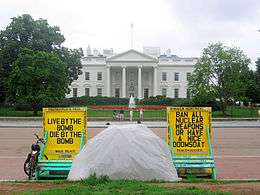Live by the sword, die by the sword
"Live by the sword, die by the sword" is a proverb in the form of a parallel phrase, derived from the Gospel of Matthew (Matthew 26, 26:52): "Then said Jesus unto him, Put up again thy sword into his place: for all they that take the sword shall perish with the sword."
Original Biblical quotation
The phrase comes from the Gospel of Matthew (Matthew 26, 26:52), in which one of Jesus's disciples is described as having struck the servant of the High Priest of Israel and cut off his ear.[1] Jesus is described as having rebuked him, saying:[2]
| Version | Text |
|---|---|
| Original Greek New Testament | τότε λέγει αὐτῶ ὁ ἰησοῦς, ἀπόστρεψον τὴν μάχαιράν σου εἰς τὸν τόπον αὐτῆς, πάντες γὰρ οἱ λαβόντες μάχαιραν ἐν μαχαίρῃ ἀπολοῦνται.[3] |
| Latin Vulgate | Tunc ait illi Jesus: Converte gladium tuum in locum suum: omnes enim, qui acceperint gladium, gladio peribunt.[4] |
| King James Version (KJV) | Then said Jesus unto him, Put up again thy sword into his place: for all they that take the sword shall perish with the sword. |
| New Revised Standard Version (NRSV) | Then Jesus said to him, "Put your sword back into its place; for all who take the sword will perish by the sword." |
| New International Version (NIV) | "Put your sword back in its place," Jesus said to him, "for all who draw the sword will die by the sword." |
The saying "all they that take the sword shall perish with the sword" is only found in the Gospel of Matthew and not in any of the other gospels.[2] The Latin version refers to the weapon as a gladius, while the Greek version refers to it as a makhaira.
Interpretations
The sayings is usually interpreted to mean "those who live by violence will die by violence",[5] which some have interpreted as a call for Christian pacifism[6] or even complete nonviolence, including in self-defense.
History
A very similar line is spoken by Clytemnestra, the wife of Agamemnon and queen of Mycenae in Greek mythology.[7][8][9] Agamemnon was part of the Oresteia, a trilogy of tragic dramas by the ancient Greek dramatist Aeschylus and was first performed in 458 BCE. The play remains popular to this day and is regularly performed[10][11] and widely read.[12][13]
References in popular culture

- The saying is paraphrased in the slogan "live by the bomb, die by the bomb" used in The White House Peace Vigil protest.
See also
References
- Senior 1985, pp. 85–86.
- Senior 1985, p. 86.
- WikiSource:Κατά_Ματθαίον
- "Latin Vulgate Bible with Douay-Rheims and King James Version Side-by-Side+Complete Sayings of Jesus Christ". Latinvulgate.com. Retrieved 2017-01-15.
- "Those who live by the sword die by the sword - Idiom Definition". UsingEnglish.com. Retrieved 2017-01-15.
- John David Geib (2007). Gail M. Presbey (ed.). Philosophical Perspectives on the 'War on Terrorism'. p. 401.
War and Peace in Christian Tradition: Why I am an engaged Christian pacifist
- Fagles, Robert (1984). The Oresteia. Penguin Books. ISBN 9780140443332.
- "The Agamamnon". archive.org. 1920-01-01. Retrieved 2017-07-26.
- Hughes, Ted (2000). The Oresteia of Aeschylus: A New Translation by Ted Hughes. Farrar, Straus and Giroux. ISBN 9780374527051.
- http://www.cambridgegreekplay.com/plays/2010/agamemnon
- https://events.ku.edu.tr/detail.php?i=9120
- http://www.goodreads.com/book/show/1524.Agamemnon
- https://www.amazon.com/Aeschylus/e/B000AQ6P2Q
Bibliography
- Senior, Donald (1985), The Passion of Jesus in the Gospel of Matthew, Collegeville, Minnesota: Liturgical Press, ISBN 0-8146-5460-6CS1 maint: ref=harv (link)